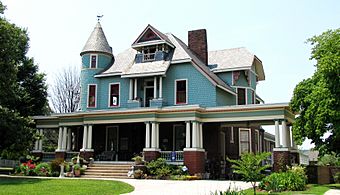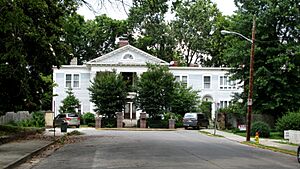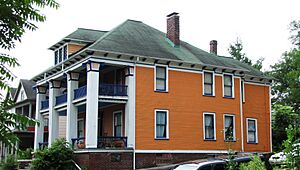Old North Knoxville facts for kids
Quick facts for kids |
|
|
Old North Knoxville Historic District
|
|

Lou Mar (505 East Scott Avenue), built in 1889
|
|
| Location | Roughly bounded by E. Woodland, Bluff, Armstrong, E. Baxter, and Central Aves. Knoxville, Tennessee |
|---|---|
| Area | 324 acres (131 ha) |
| Built | c. 1883–1940 |
| Architect | George Barber, Charles I. Barber, David Getaz, and multiple others |
| Architectural style | Bungalow/Craftsman, Late Victorian, Late-19th and 20th Century Revivals |
| NRHP reference No. | 92000506 |
| Added to NRHP | May 14, 1992 |
Old North Knoxville is a neighborhood in Knoxville, Tennessee, United States. It's located just north of the city's downtown area. This area started as the town of North Knoxville in 1889. It was a popular place for well-off families and professionals until the 1950s.
After some tough times, people who cared about history began fixing up many houses in the 1980s. In 1992, over 400 homes and other buildings in the neighborhood were added to the National Register of Historic Places. This means they are officially recognized as important historical sites. The area is now known as the Old North Knoxville Historic District.
After the American Civil War, Knoxville grew very quickly. More people moved to the city, and it expanded north and west. Building new homes reached what is now Old North Knoxville in the late 1880s. It became its own town called North Knoxville.
Even after Knoxville took over the town in 1897, building continued. Doctors, politicians, and business leaders were among the first people to live here. Some early homes were designed by famous architects like George Barber. As Knoxville kept growing, especially when it added Fountain City in 1962, North Knoxville became "Old" North Knoxville.
Contents
Where is Old North Knoxville?
Old North Knoxville is found right off Broadway, which is part of U.S. Route 441. It's about halfway between downtown Knoxville and Sharp's Ridge. The neighborhood sits on a hill. This hill gently rises from First Creek and goes down towards Second Creek.
East Scott Avenue runs along the top of this hill. Homes on East Scott are about 20 to 40 feet higher than others. The Old North Knoxville Historic District has clear boundaries. It's bordered by East Woodland Avenue to the northwest and Bluff Street to the northeast. Armstrong Avenue is to the east, and Central Avenue is to the south.
Other historic areas are close by. These include Mechanicsville to the southwest and Fourth and Gill to the south. Park City is to the east, and North Hills is to the northeast.
History of the Neighborhood
North Knoxville was mostly farmland until the late 1800s. A map from 1871 shows very few buildings north of the Knoxville National Cemetery. But after the Civil War, Knoxville became a big center for warehouses and textile factories. This was thanks to its railroads and money from the North. The city's population grew very fast.
By 1886, some houses and roads were built in what is now Old North Knoxville. Factories like the Brookside Cotton Mill were also built nearby. Instead of waiting for Knoxville to provide city services, North Knoxville became its own city on January 16, 1889. L. A. Gratz was its first mayor.
The new town got better water and electricity than Knoxville had. The North Knoxville School was also highly respected. At that time, North Knoxville was seen as one of the best places to live in the area. By 1895, about 3,200 people lived there. Knoxville officially took over North Knoxville in 1897.
By the early 1900s, streetcars connected North Knoxville to downtown. The neighborhood was mainly home to well-to-do professionals. These included business managers, doctors, lawyers, and professors. One part of Glenwood Avenue was even called "Doctors' Hill." This was because almost every house there belonged to a doctor.
Important business leaders lived here too. These included William Lang from Brookside Cotton Mill and Benjamin Morton, who led The H. T. Hackney Company. Morton later became mayor of Knoxville. Several officials from the Southern Railway also lived in the neighborhood. George Dempster, who invented the Dempster-Dumpster and was also a mayor of Knoxville, lived here in the 1920s.
North Knoxville kept growing until the 1940s. By then, many of the first residents had moved away or passed on. As Knoxville expanded and cars became popular, people started moving to newer neighborhoods further out. In the 1950s and 1960s, many large homes were turned into cheaper apartments. This caused house values to drop. However, the Old North Knoxville Neighborhood Association formed in the 1970s. This group helped restore and fix up most of the historic homes.
Old North Knoxville Historic District
The Old North Knoxville Historic District covers about 324 acres. It includes properties on many streets like Alexander Street, Glenwood Avenue, and East Scott Avenue. The district has 496 important buildings and structures. Most of these are houses and their smaller outbuildings. There is also one commercial building.
The neighborhood is known for its short front lawns and wide sidewalks. You can still find "Granitoid" pavement from around 1907 on Kenyon Street. People call it "singing" pavement because of the sound cars make when they drive over it.
Homes in Old North Knoxville were designed by famous architects. These include George F. Barber, his son Charles Barber, and David Getaz. You can see many different architectural styles here. Some popular styles are Queen Anne, Folk Victorian, and Bungalow/Craftsman. There are also homes in Dutch Colonial Revival, Tudor Revival, and Neoclassical Revival styles.
Cool Homes to See
- W. R. Cooper House (1212 Kenyon Ave.): This Folk Victorian house was built around 1883. It was moved about a block to its current spot in 1900.
- Thomas Fitzgerald House (311 Glenwood Ave.): A Folk Victorian house built around 1888.
- Lou-Mar (505 East Scott Avenue): Built in 1889, this Queen Anne-style house was designed by architect David Getaz.
- James Eugene Fair House (241 East Scott Ave.): A Queen Anne-style house built in 1896.
- Pine Crest (131 East Scott Avenue): This Folk Victorian house was built in 1899 for William Lang, a manager at Brookside Mills. It was designed by architect George F. Barber.
- James B. Dunn Mansion (1424 Armstrong Avenue): A large Neoclassical-style house built in 1905.
- 131 East Oklahoma Avenue: A Neoclassical-style house built around 1910. It's known for its very large columns.
- 518 Glenwood Avenue: A French Eclectic-style house built in 1925. It was designed by architect Charles I. Barber.
- George Dempster House (235 East Scott Avenue): An American Foursquare-style house built in 1926. This was the home of George Dempster, a famous Knoxville businessman and mayor.
- Marble Hill (125 East Glenwood Avenue): An Arts and Crafts "bungalow mansion" built in 1916. It was designed by Martin E. Parmelee for the Samuel T. Buffat family. Buffat was an executive at the H. T. Hackney Company. Later, a banker named William S. McKinney bought the home in 1920. From 1965 to 2003, it was the home of Daniel E. Bailey. He was a well-known bluegrass musician and a radio announcer.








